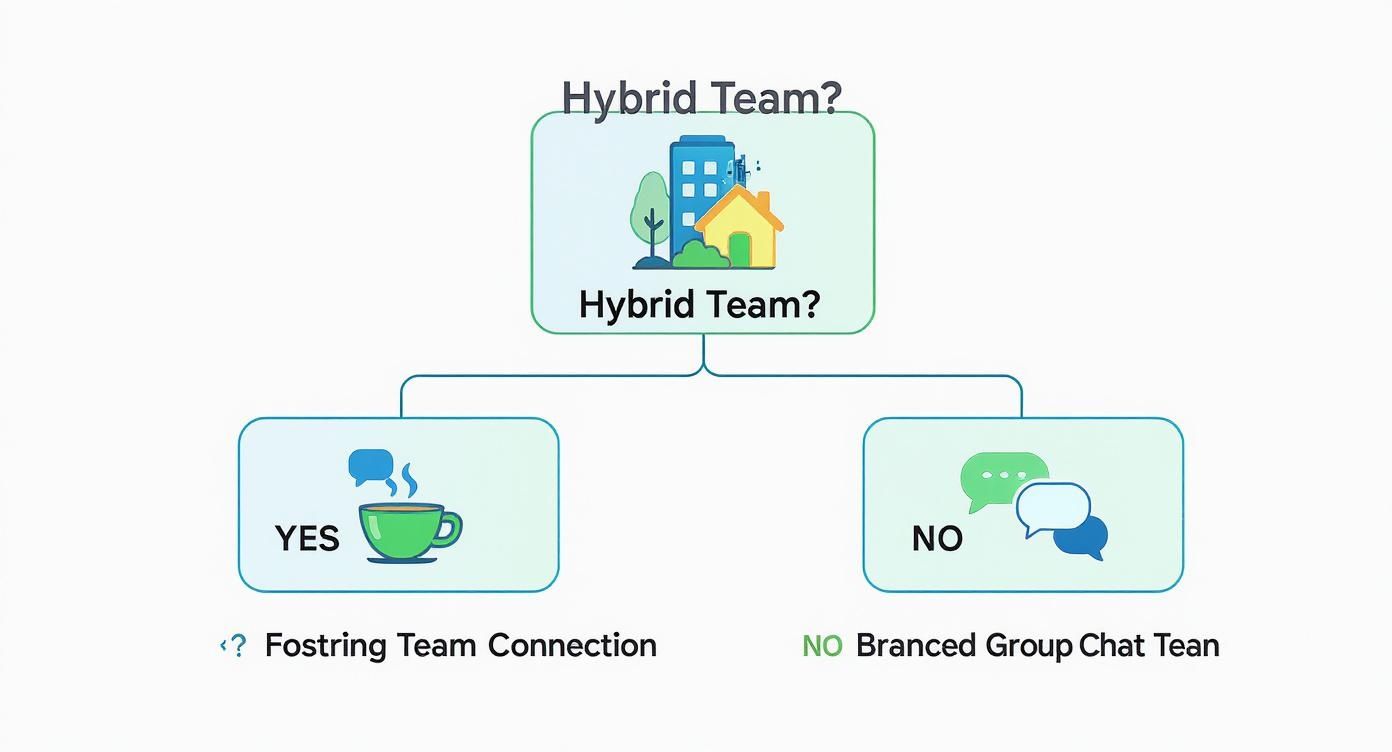Building a great workplace culture isn’t just a “nice-to-have” anymore—it’s a core business strategy. It’s about consciously creating an environment where your people feel valued, safe, and motivated. Get this right, and you’ll see the impact on everything from productivity to long-term employee retention. A thriving culture is built on daily actions, not just a dusty mission statement hanging on the wall.
Table of Contents
The High Cost of a Toxic Environment

The conversation around workplace culture has completely changed. It’s no longer a soft HR topic; it’s a critical driver of success. And ignoring it? That comes with some very real, very painful costs that can stunt a company’s growth.
A negative environment is a direct pipeline to high turnover. When people feel unheard, underappreciated, or psychologically unsafe, they start updating their resumes. That constant churn isn’t just a headache; it’s a financial drain. You’re hit with repeated recruitment fees, training costs, and a massive loss of institutional knowledge every time someone walks out the door. For example, losing a single experienced software engineer can cost a company upwards of 50-200% of their annual salary in recruitment, onboarding, and lost productivity.
Evolving Employee Expectations
Today’s workforce, especially the younger generations, is playing by a new set of rules. They’re looking for more than just a paycheck. They want purpose, a sense of belonging, and a company that genuinely cares about their well-being. The data backs this up loud and clear.
Think about this: a massive 88% of employees now say a company’s culture is a critical factor when they’re looking for a new job. For the newest members of the workforce, it’s even more crucial. 69% of Gen Z employees would actually pick a positive culture over a bigger salary.
On the flip side, a toxic environment is the number one reason nearly half of employees (45%) quit. These aren’t just numbers; they represent a fundamental shift in what people demand from their employers.
Before we dive into the “how-to,” let’s ground ourselves in the core pillars that hold up any healthy and supportive work environment. These are the elements we’ll be exploring throughout this guide.
The Core Pillars of a Thriving Workplace Culture
| Pillar | Why It Matters | Example in Action |
|---|---|---|
| Psychological Safety | Creates an environment where people feel safe to speak up, ask questions, and take risks without fear of punishment or humiliation. | A manager openly admitting they don’t have all the answers and asking the team for their ideas. |
| Trust & Respect | Forms the foundation of all healthy relationships. It ensures collaboration, open communication, and mutual support. | Teammates can rely on each other to meet deadlines without micromanagement. |
| Recognition & Value | Validates individual contributions and makes employees feel seen and appreciated, boosting motivation and engagement. | Publicly shouting out a team member in a Slack channel for going above and beyond to help a customer. |
| Growth & Development | Shows employees the company is invested in their future, not just their current output, leading to higher loyalty. | Offering a clear career path with regular check-ins and funding for professional development courses. |
| Purpose & Connection | Connects daily tasks to a larger mission, giving work meaning and fostering a sense of shared community. | Regularly sharing customer success stories that show the real-world impact of the team’s work. |
These pillars don’t exist in a vacuum; they reinforce each other to create a workplace where people genuinely want to be.
A positive culture isn’t about free snacks or ping-pong tables. It’s about creating an ecosystem of trust, respect, and mutual support where people feel empowered to do their best work.
The Power of Team Recognition
If you’re looking for one of the most effective levers to pull, start with team recognition. It’s that simple. When people feel their hard work is actually seen and appreciated, their connection to the company deepens. Team recognition is vital because it moves beyond individual achievement to celebrate collaboration, reinforcing that success is a collective effort. It validates effort, reinforces the exact behaviors you want to see more of, and builds a powerful sense of “we’re in this together.”
Imagine a developer who stays late to push a critical bug fix. A quick, public “thank you” from their manager in the team’s Slack channel does more than just make that one person feel good. It sends a powerful message to everyone: we value dedication and problem-solving here. That small act strengthens team bonds and builds a culture of appreciation.
Ignoring those contributions? That’s a fast track to disengagement and burnout. Building a strong recognition program is a cornerstone strategy to improve employee retention.
Building Culture with Leadership and Trust

While HR can lay the groundwork, a positive workplace culture is truly built in the trenches, through the daily actions of its leaders. It’s the managers and team leads who turn company values from words on a wall into a lived reality. This kind of empathetic, hands-on leadership is the engine that drives employee trust and creates the psychological safety a team needs to actually innovate and thrive.
This isn’t just a feel-good theory. It’s a critical piece of the puzzle for any healthy organization, especially in a world that feels like it’s in constant flux. Global research shows a clear link: employees who have high confidence in their leaders report far better workplace experiences, even when things are tough. This makes leadership the secret ingredient for resilience and engagement, which is more important than ever. Dig into the data yourself in this in-depth 2025 trends report.
From Boss to Empowering Leader
There’s a world of difference between a boss who just doles out tasks and a leader who empowers their team. A boss manages a to-do list; a leader cultivates talent and trust. You can see this difference in how they handle everyday challenges.
Picture this: a project hits a major, unexpected snag.
- The Boss: “Why is this delayed? I need it fixed now. Give me hourly updates until it’s done.” This reaction breeds fear and blame, making it less likely anyone will flag a problem early next time.
- The Leader: “Okay, looks like we’ve hit a roadblock. Let’s walk through it. What do you need from me to get us back on track?” This approach fosters collaborative problem-solving and reinforces that it’s safe to be honest about hurdles.
That simple shift from directing to guiding is everything. It’s how you build a culture where people feel supported, not scrutinized.
Transforming One-on-Ones into Coaching Sessions
One-on-one meetings are probably the most powerful—and most underused—tool a leader has. All too often, they devolve into routine status updates that could have easily been a Slack message. To build real trust, these meetings need to be genuine coaching and connection sessions.
Instead of just asking, “What are you working on?” try mixing in more open-ended questions that look to the future:
- “What was a win for you this week, and what did you learn from it?”
- “Are there any obstacles I can help clear out of your way?”
- “What part of your work is getting you the most energized right now?”
- “How are you feeling about your workload? Is your work-life balance in a good place?”
These questions pivot the conversation from pure output to personal development. They show you care about the person’s growth and well-being, not just their checklist. For instance, if an employee mentions they are energized by a particular task, a great leader can follow up with, “That’s great to hear. Let’s explore ways you can do more of that kind of work in the next quarter.”
A leader’s job isn’t to have all the answers. It’s to create an environment where the best ideas can surface—and that only happens when trust is high and the fear of failure is low.
A tangible way to prove you’re committed to your team’s growth is by investing in comprehensive learning and development courses. It shows you’re willing to put resources behind their careers, which builds incredible loyalty.
The Importance of Team Recognition
Beyond individual coaching, great leaders are champions of team recognition. And I don’t just mean celebrating the huge, project-closing wins. It’s about consistently and publicly acknowledging the daily efforts that lead to that success. Team recognition is critical because it builds camaraderie and reinforces that wins are a collective effort. It prevents a culture of solo superstars and instead fosters a supportive, collaborative environment where everyone feels they play a role in the company’s success.
When a leader personally gets involved in peer-to-peer recognition—whether it’s shouting someone out in a Slack channel or a team meeting—it sends a powerful message. It validates the act of appreciation and encourages everyone else to join in. It’s a simple act that reinforces the idea that every single contribution matters, cementing that foundation of trust across the whole team.
Making Recognition a Daily Habit

If there’s one tool in your culture-building kit that’s both incredibly powerful and shockingly underused, it’s recognition. It’s the engine that makes people feel seen, valued, and genuinely connected to their work.
But let’s be honest, the old ways just don’t cut it anymore. The annual awards dinner? The dusty “employee of the month” plaque? Those are relics. For appreciation to actually mean something, it needs to be part of the daily rhythm of your team’s work.
This isn’t just a nice-to-have. When people get consistent and authentic praise for their efforts, they’re more motivated, more engaged, and far more likely to stick around. We’re not talking about grand, over-the-top gestures. It’s the small, frequent shout-outs that build momentum and tell people, “Hey, what you do matters here.” This is how you shift appreciation from a top-down mandate to an organic, peer-driven habit.
The Power of Peer-to-Peer Recognition
I’ve seen it time and again: the most vibrant company cultures are built on the foundation of strong peer relationships. Peer-to-peer recognition is what lets those relationships flourish. It takes the responsibility for praise off the shoulders of managers and puts it into the hands of everyone on the team. This single move builds camaraderie and trust in a way that top-down recognition never could.
Think about it. When a colleague—someone who’s right there in the trenches with you—takes a moment to publicly acknowledge your hard work, it just hits differently. It comes from a place of real understanding. For example, a designer shouting out an engineer for catching a small but critical UI bug shows mutual respect for each other’s expertise. This creates a powerful feedback loop where team members feel supported by the people they collaborate with every day, fostering a genuine sense of belonging.
True recognition isn’t an event; it’s a behavior. By empowering everyone to give praise, you create a culture where appreciation is woven into the fabric of every interaction.
Making Recognition Specific and Impactful
For praise to really land, you have to get beyond a generic “good job.” While nice to hear, it doesn’t do much. The real magic is in the details. Vague praise is forgettable, but specific praise is actionable—it shows someone exactly which behavior to repeat.
So, how do you make recognition stick?
- Make It Timely: Don’t wait. A thank you delivered right after a win has ten times the impact of one saved for the weekly meeting.
- Get Specific: Spell out what the person did and, crucially, why it mattered. Connect their action to a real outcome for the team, the project, or a customer.
- Tie It to Your Values: If you can, link the recognition back to one of your core company values. This is a subtle but powerful way to reinforce the culture you want.
For example, instead of just saying, “Great work on the presentation, Mark,” you could level it up:
- Example 1: “Huge props to @Mark for the client presentation today. The data visualization you created made a complex topic easy to understand and was a key reason we got their buy-in. That’s a perfect example of our ‘Clarity’ value in action.”
- Example 2: “Shout-out to @Priya for jumping in to help QA the new feature on a tight deadline. Your attention to detail saved us from a major bug, and I really appreciate you being such a team player.”
This level of detail doesn’t just feel good; it validates the person’s specific contribution and proves their work is actually being seen. If you’re looking for more ways to get creative with your appreciation, we’ve got a ton of ideas in our guide on unique employee appreciation ideas.
Integrating Recognition into Your Workflow
Here’s the secret to making recognition a real habit: make it ridiculously easy. It needs to be effortless. The best way to do that is to build it right into the tools your team already lives in every day, like Slack.
A dedicated Slack channel, for instance, creates a public, real-time feed for celebrating wins. A tool like AsanteBot can crank this up a notch by adding a fun, game-like layer with points, leaderboards, and even tangible rewards, which naturally encourages everyone to participate more often.
Here are a few practical ways to get the ball rolling:
- Create a #wins or #kudos Channel: Give recognition a home. This creates a searchable, positive archive of team accomplishments that anyone can look back on.
- Carve Out Meeting Time: Kick off your team meetings with a “round of wins.” Ask everyone to share a personal success or recognize a colleague. It immediately sets a positive tone.
- Lead by Example: This one’s non-negotiable. Managers and leaders have to be the most active participants. When they consistently give specific, public praise, it sends a clear signal that this behavior is what you value as a company.
By making recognition a visible, easy, and consistent part of your daily operations, you’re not just checking a box. You’re actively building a better culture, one shout-out at a time.
Building Connection in a Hybrid World
Flexibility is one of the biggest perks of modern work, but it throws a curveball at company culture. How do you keep your team tight-knit when they’re spread across home offices, coffee shops, and the actual office? Those spontaneous coffee-maker chats that used to build relationships don’t just happen anymore. You have to build them intentionally.
Without that deliberate effort, hybrid and remote work can quickly lead to disconnected, siloed teams. But the answer isn’t to drag everyone back to their desks five days a week. It’s about getting smart and being intentional about creating a positive workplace culture through shared experiences that work for everyone, wherever they are.
This isn’t just a feeling; the numbers back it up. A recent global survey from the Gensler Research Institute revealed that even as remote work became the norm, the time people spent collaborating and socializing in person actually went up. These moments are gold for building real relationships and cementing your culture. You can explore the full workplace survey findings here for a deeper dive.
Make In-Office Time Count
When you do bring people together, make every moment matter. The office shouldn’t just be a different place to do the same solo work. It needs to be a hub for the kind of energy and collaboration you just can’t get through a screen.
Make your in-office days feel special by building them around things best done face-to-face:
- Collaboration Days: Dedicate specific days for the whole team to dive into big brainstorming sessions, kick off new projects, or hold workshops that benefit from having everyone in the same room. For example, a marketing team could use an in-office day to storyboard a new campaign on a whiteboard, a process that thrives on live, dynamic interaction.
- Team-Building Lunches: It sounds almost too simple, but sharing a meal is a low-pressure, high-impact way to build genuine rapport.
- Skill-Sharing Sessions: Get people to host casual “lunch and learns.” They can share anything from a nifty software shortcut to a passion for baking. It’s a great way to learn from each other on a personal level.
This shifts the office from being a requirement to being a resource.
The new purpose of the office is connection. If you’re calling people in, make it a magnet, not a mandate. Focus on the collaborative, social, and creative moments that simply can’t be replicated through a screen.
Create Virtual Water Coolers
For your remote folks, you have to create those “hallway moments” digitally to keep them from feeling isolated. These don’t need to be complicated, just consistent and authentic.
Here are a few ideas that actually work:
- Virtual Coffee Chats: Use a tool that randomly pairs up team members for a quick 15-minute chat. Toss in a few fun conversation starters to get things rolling and skip the awkward silences.
- Fun Slack Channels: A dedicated channel like
#pet-photos,#good-eats, or#weekend-adventuresgives people a space to share a bit of their lives outside of work, building personal connections over time. - Virtual Team Games: A quick 30-minute online game on a Friday afternoon is a fantastic way to unwind and share a laugh, strengthening bonds without feeling like another mandatory meeting.
For companies working with distributed teams, there’s more great advice on cultivating a positive work culture within remote teams.
Why Recognition is Non-Negotiable
In a hybrid setup, visibility is a huge deal. “Out of sight, out of mind” can become a real problem. That’s why a strong, visible recognition program is absolutely essential for creating a positive workplace culture that includes everyone. Recognizing team members publicly ensures that contributions are seen, regardless of location. It’s vital for preventing proximity bias, where in-office employees receive more acknowledgment simply because they are more visible.
When someone’s hard work is shouted out in a public channel, it doesn’t just make them feel good; it reinforces their value and connects them to the bigger picture. It’s a simple act that bridges the physical gap, ensuring every single person—whether at home or in the office—feels seen, valued, and truly part of the team.
How to Measure and Sustain Your Culture
A great workplace culture isn’t a project you complete and then check off a list. It’s more like a garden—it needs constant tending to flourish. If you just launch a big initiative and then walk away, even the most positive changes will eventually wither. The real secret is to measure what matters and create a rhythm of continuous improvement.
This means we need to think beyond the once-a-year engagement survey. By the time you get those results, the feedback is already months old. To get a real-time pulse on your cultural health, you need nimbler, more frequent methods that capture how your team is actually feeling, week in and week out.
Going Beyond the Annual Survey
Traditional surveys have their place, but if you want to keep the momentum going in creating a positive workplace culture, you need a more dynamic set of tools. It’s like checking the weather forecast every morning instead of just once a season—you need real-time data to make smart adjustments on the fly.
Here are a few powerful ways I’ve seen companies get a much clearer picture:
- Pulse Surveys: These are your best friend for real-time feedback. Think short, frequent check-ins (weekly or bi-weekly) with just a handful of questions. They’re fantastic for tracking key metrics over time, helping you spot a downward trend before it snowballs into a major issue. A simple question like, “How likely are you to recommend our company as a great place to work?” gives you a consistent eNPS score to watch.
- Stay Interviews: Why wait for an exit interview to find out what went wrong? Instead, sit down with your best people and ask them why they stay. I love questions like, “What do you look forward to when you come to work each day?” or “What’s one thing that would make your job even better?” The answers are pure gold and tell you exactly what you’re doing right.
- Analyzing Recognition Data: The qualitative feedback flowing through your peer recognition platform is a goldmine. Seriously, read the shout-outs. What words are people using? Are they celebrating collaboration, innovation, or customer obsession? This is how you find out which of your company values are truly alive and breathing on the front lines.
This infographic lays out a simple but effective decision tree for fostering team connection, which is a huge piece of building a sustainable culture, especially with so many different work setups these days.

As you can see, it really boils down to intentional communication, whether that means setting up virtual coffee chats for a hybrid team or just making sure your remote folks have a dedicated group channel to connect in.
Key Metrics to Track Cultural Health
To really get a handle on your culture, you need to track a mix of quantitative and qualitative data. This gives you both the “what” and the “why.” A high turnover rate tells you there’s a fire, but the candid feedback from stay interviews tells you where the smoke is coming from.
Don’t get lost in a sea of data. Just focus on a few core metrics that tell the biggest story:
| Metric | What It Tells You | Practical Example |
|---|---|---|
| Employee Net Promoter Score (eNPS) | Measures employee loyalty and how willing they are to advocate for your company. | A quarterly pulse survey asks, “On a scale of 0-10, how likely are you to recommend us as a place to work?” |
| Voluntary Turnover Rate | Shows the percentage of employees choosing to leave—a direct gut-check on cultural health. | If your turnover rate for a key team jumps from 5% to 15% in six months, you have a clear signal to investigate that team’s micro-culture. |
| Peer Recognition Frequency | Tracks how often people are giving props to each other, a great indicator of engagement and camaraderie. | Using a tool like AsanteBot, you can see if shout-outs spike after launching a new values campaign. |
Think of these metrics as the dashboard for your culture. They let you see at a glance where you’re winning and where you need to step in.
Sustaining a positive culture is less about grand gestures and more about consistent, small actions. It’s the daily check-ins, the regular recognition, and the commitment to listening that keep the momentum going.
Common Pitfalls and How to Fix Them
Even with the best intentions, I’ve seen culture initiatives lose steam. The number one reason they fail? A lack of sustained commitment. People treat it like a one-off campaign instead of an ongoing practice.
Another classic pitfall is letting culture become an “HR-only” task. While HR can and should champion the effort, culture is everyone’s job. If managers aren’t actively modeling the behaviors you want to see and participating in recognition, the whole thing will feel hollow and inauthentic to their teams.
The fix is straightforward but requires discipline: embed cultural practices into your leadership routines.
- Make recognition a meeting habit. Kick off every team huddle with a “wins and kudos” round. It takes two minutes and completely changes the energy in the room. For example, a sales manager could start a Monday meeting by saying, “Before we dive into numbers, let’s go around and share one peer we want to recognize for their help last week.”
- Train managers on giving feedback. Give your leaders the tools to have meaningful conversations about growth and well-being, not just project deadlines.
- Share the data. Be transparent. Show your teams the survey results and, more importantly, what actions you’re taking based on their feedback. This builds trust and proves you’re serious.
When you make these actions a non-negotiable part of how you operate, culture stops being a poster on the wall and becomes the way you actually get work done.
Common Questions About Building a Great Workplace Culture
Even with the best game plan, you’re bound to hit a few snags. Building a positive culture is more art than science, and it often brings up some tricky situations. Here are some of the most common questions I hear from leaders, along with some straightforward advice to keep you on track.
What Do I Do About Employees Who Resist Cultural Changes?
Resistance isn’t usually about being difficult; it’s almost always rooted in a fear of the unknown or feeling like their voice doesn’t matter. So, before you try to enforce anything, just listen. Sit down for a one-on-one and ask open-ended questions to figure out what’s really going on.
Once you understand their hang-ups, you can address them head-on. For example, if someone is dragging their feet on a new peer recognition program, you could frame it as a tool to make their own hard work more visible to leadership—not just another box to check. When people see leaders consistently walking the talk and understand the “why” behind the shift, they’ll realize it’s a real commitment, not just another short-lived HR initiative.
We’re on a Tight Budget. What Are Some Low-Cost Ways to Improve Our Culture?
You don’t need a huge budget to build a great culture. In fact, some of the most powerful habits cost nothing more than a bit of intention and time. A solid recognition program is probably the highest-impact, lowest-cost thing you can do. The importance of team recognition can’t be overstated; it fosters connection and motivation without requiring a financial investment.
Here are a few ideas you can put into action today, for free:
- Create a
#kudosChannel: Fire up a dedicated channel in Slack or Teams. It immediately creates a public forum for celebrating wins, big and small. - Kick Off Meetings with Wins: Spend the first five minutes of your team meetings sharing successes. It completely changes the energy in the room.
- Lean into Flexibility: If the roles allow, offering flexible hours or remote options costs you nothing but signals a massive amount of trust and respect for your team’s lives outside of work.
- Coach Your Managers on Feedback: Training leaders to give specific, meaningful praise is a skill. It builds morale far more effectively than a gift card ever could.
A healthy culture is built on daily habits of respect and appreciation, not expensive perks. Consistency in these small actions creates a significant, positive impact over time.
How Long Does It Actually Take to See a Real Change?
You’ll start seeing the small green shoots pretty quickly—maybe within a few months. Things like more people speaking up in meetings or a more active kudos channel are fantastic early indicators that you’re on the right path.
But deep, foundational change is a long game. Realistically, you should expect to see a meaningful shift in metrics like voluntary turnover or your employee Net Promoter Score (eNPS) in about 6 to 12 months of sustained effort. For those new habits to become “just the way we do things here,” you’re likely looking at 18 months or more. The secret ingredient is unwavering and visible commitment from the leadership team.
Can You Really Have a Strong Culture with a Fully Remote Team?
Absolutely, but you have to be way more intentional about it. You can’t just hope for a great remote culture to happen; you have to actively build it. The goal is to manufacture the moments of connection that used to happen naturally by the coffee machine.
This means you have to prioritize communication and trust just as much as you prioritize deliverables. This is where a vibrant peer recognition system becomes non-negotiable, as it’s a powerful tool for building team cohesion from afar. It makes everyone’s contributions visible, regardless of their time zone. A quick shout-out in Slack for a developer who pushed a late-night fix ensures the whole team sees it, bridging that physical distance and reinforcing that their work matters.
Ready to make recognition an effortless, daily habit for your team? AsanteBot integrates seamlessly with Slack to build a fun, engaging, and measurable culture of appreciation. Get started for free in just two minutes.




